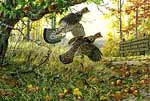
Coveys of "Gentleman Bob" obligingly held tight in front of southern pointing dogs before a hunter's boot sent them buzzing off the ground like a feathered explosion. And northern gunners still catch their hearts in their throats when a ruffed grouse thunders up out of the gnarlies and rockets his way toward safety beyond leafy cover. Whether he chooses to hunt with one of the pointing breeds, a flushing dog or even dogless, the upland hunter is routinely presented with a classic rising shot.
Since the rising bird is such a common shot, the technique for shooting it is very important. There is even a shooting game dedicated to this shot. Trap, the most popular shooting sport in America, is designed solely around shots at rising outbound birds from random angles. Guns set up for trap shooting typically incorporate some simple design features so they remember that the target is rising even if the shooter forgets.
Figure (1) shows a typical example of the shot at a rising bird. As the bird comes into view at A, the gunner begins his mount and the muzzle rotates up and through the bird, taking it just beyond B.

Figure (1)
Every now and then, though, the technique for shooting rising game can really hurt your score afield. I'm talking, in particular, about those birds that have already gotten up a head of steam - maybe they were put up by your friend or his dog - and are now flying straight and level away from you. As you see the pheasant's tail heading away pronto, you rotate your 12 gauge up and through the bird and slap the trigger. Instead of a spray of feathers, you just see that rooster heading over the horizon. What happened?
A quick peek at figure (2) shows what the gunner must do with this shot, as counter as it might be to what we've learned from birds flushed from the ground. As the bird heads straight away at A, the gunner has to make his mounting move and then slip his muzzle below the bird, not up and through it. The hunter will not want to obstruct his view of his target by elevating the muzzle above the bird and then rotating down. An alternative technique might be to insert the muzzle on the bird's belly and then just "ease off" a bit, taking the bird a bit beyond B.

Figure (2)
Next time a bird has a flying start on you and sails by like an outbound express, remember the diagrams you saw here. They're not as complicated as the ones that confused you in high school geometry, and they may help you add a bird or two to your bag.





No comments:
Post a Comment